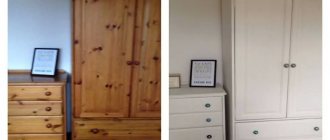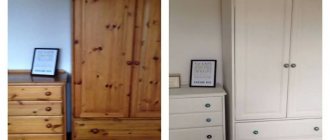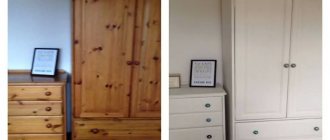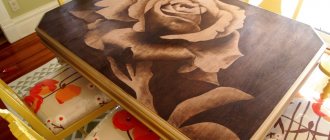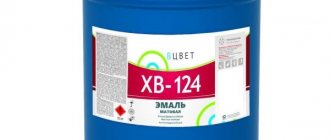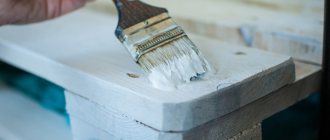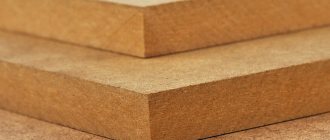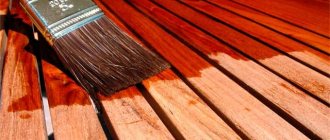These instruments come in different types, sizes, shapes and finishes. At the same time, the question of how to choose a paint roller depends on the type of work that you are going to carry out with its help.
Paint roller: types
There are paint rollers on the market today that are suitable for different types of repair work and paint products. To choose the right roller for painting with water-based paint, it is better to first pay attention to the material from which the product is made.
To cover the surface with water-based paint, you need a roller consisting of the following materials:
- pile;
- velours;
- foam rubber
Rollers made of different materials are within the same price category, so it is quite difficult for an inexperienced buyer to choose. Don’t hesitate to ask sellers and consultants which roller is better and what operating features are typical for each of them. The material from which the roller is made directly affects what the final painting result will be.
The final result of painting depends on the material from which the roller is made
Sizes and types of paint rollers
In turn, paint rollers differ in the length of the coat, the width and diameter of the working surface.
- Small rollers up to 15 cm long and up to 3 cm in diameter are used for painting narrow or small surfaces, or hard-to-reach places.
- The average roller has a length from 15 to 25 cm and a diameter from 5 to 9 cm. Rollers of this size are considered universal; they are used for most painting jobs, as well as for leveling wallpaper when gluing.
- Large roller. Its length is over 25 cm, and its diameter is from 8 cm. Such rollers are used for facade painting. Working with such a tool requires professional skills and some experience.
The handle length of the rollers also varies - from 35 cm to 50 cm. If necessary, you can purchase a telescopic handle. It will lengthen the roller, and then you can use it to paint a surface that is high up without using a stepladder.
Roller models
There are several types of paint roller
- For painting. They are used for painting walls, ceilings, applying varnish, primer, etc. The soft coat absorbs the paint, then it is applied to the surface with a rolling motion.
- Textured models for plaster. With their help, you can create all kinds of reliefs and patterns on a plastered or painted surface.
A type of textured roller is paneled. It is intended for creating decorative paintings on walls without using a stencil. - Needle rollers. An option for self-leveling flooring is a roller with rubberized spikes. They are used to remove air bubbles from a poured solution or when working with viscous paints.
For drywall, the roller has sharp spikes that pierce the surface so that the material is better saturated with moisture and can be bent to the desired shape. Also, such a roller is also used during repairs to remove old non-woven or vinyl wallpaper from walls. - Corner roller. This is a narrow wheel of small diameter on a clasp with a handle. This roller is used for painting corners or hard-to-reach areas of the room.
- Roller for pipes and radiators. This model is like an elongated wire handle, at the end of which two or three rollers are attached. The diameter of these rollers may vary depending on the diameter of the pipe.
- Pressure (or stitching) roller. This is a design with a dense rubber or polyurethane coating. It is used when gluing wallpaper to smooth and remove air bubbles.
Material for roller coats
The types of material from which roller coats are made are quite varied.
- Polyamide, nylon. This is an artificial fiber with increased resistance to chemical attack and abrasion. The length of the pile varies from 8 to 20 mm. Such coats are used mainly for applying water-dispersion paints. The longer the pile, the easier it is to apply paint with such a roller on a rough surface.
- Acrylic (polyacrylic). A synthetic fiber that resembles wool, but with a dense pile. This type of pile allows you to reduce the amount of splashes during painting. Also suitable for applying water-based paints, but not suitable for chemically aggressive materials.
- Polyester. Outwardly it resembles a padding polyester. It has excellent paint absorption and retention abilities and does not leave lint when applied. But it is very short-lived and has low durability.
- Fur covering. Includes both real and faux fur. Natural fur is made mainly from sheep's wool. Suitable for using various enamels, varnishes, oil and water-dispersion paints, but recommended for working with lime. If the wool is poorly processed, then such a roller may leave fluff on the surface to be painted.
Faux fur (vestan) is used for applying all types of paints. In connection with this, a faux fur roller coat is considered universal. - Velours. This is a woven backing with plush pile. They don't splatter paint or roll off. These rollers are used for finishing smooth surfaces. Resistant to solvents. Such rollers are used when working with alkyd paints, oil-based and water-dispersion paints.
- Foam rubber. Used for working with water-dispersion paints and water-based varnishes. This coat quickly restores its original shape, but during the process small bubbles remain on the surface, making it uneven.
- Flock. Polyurethane fiber glued to a textile base. Very durable, waterproof and environmentally friendly material. Used for finishing painting of particularly smooth surfaces.
As a rule, the manufacturer indicates on the packaging what types of painting a particular roller is intended for. When choosing a model, base it on what you need the roller for.
Attaching the roller coat to the roller
There are several types with which the fur coat is attached to the roller.
- Glued look. A strip of fur coat is wrapped in a spiral around a roller treated with glue. The connection is made end-to-end, and because of this the roller is seamless. When working with such a roller, the paint is applied evenly, without forming streaks, but due to the fact that the coat is not removable during this application, it cannot be replaced. The roller will have to be thrown away when it has served its purpose.
- Thermo-glued. This is a method of thermally welding the coat material onto a roller. The material strip is wound onto a roller heated to the maximum permissible temperature. The surface is also seamless and does not leave marks on the painted surface. These rollers are more durable than glue rollers.
- Replaceable coats. Such coats are fixed on the roller with special plugs.
From foam rubber
The main advantage of using foam rollers for applying water-based paint is their low cost, as well as the ability to purchase them at any, even the smallest, repair store. One roller can be made from several types of foam rubber.
Pay attention to the percentage of high-density foam rubber, it is this that ensures resistance to mechanical stress.
However, foam rubber products have their disadvantages:
- the roller absorbs more paint than necessary, which is unprofitable from the point of view of rational use of materials;
- Due to excessive impregnation of foam rubber with water-based paint during work, a large number of bubbles may form on the surface and the coating will be uneven.
The main advantage of foam rollers is their low cost.
Which roller to paint the ceiling with
The roller for ceilings must be selected according to the same criteria as for walls. Typically, a ceiling roller, unlike a wall paint tool, has a relatively short or medium-sized handle. The quality requirements for ceiling painting are usually higher, so the roller needs to be chosen more carefully. Most often, rollers with slightly elongated soft pile are used for painting ceilings. It is very good if such pile is made from natural materials, for example, wool. Pile that is too short does not pick up enough paint. You can use a foam roller for the ceiling, but it is not the best choice: it creates “bubbles”.
Paint applied to a roller cannot be rolled out directly onto the ceiling, as this will lead to unevenness of the layer. It must first be rolled out on a sheet of linoleum, hardboard or other similar material specially prepared for this purpose. This can also be a special painting tray if the roller size is small.
Made from velor
It is advisable to choose such a roller for painting a flat, smooth surface. Velor is a synthetic material and products made from it are much cheaper than, for example, mohair rollers. Another undoubted advantage of velor rollers is their resistance to aggressive solvents.
However, the inconvenience in using this type of product is that velor does not absorb water-based paint well. In order to achieve an even, uniform coating, you will have to dip the tool into the coloring solution too often, which creates a lot of inconvenience for the painter.
Roller technology
To get a perfectly smooth and neatly painted surface, you need the correct technique for working with a roller. It has characteristic features:
- Painting boundaries are marked with masking tape. It must be at the same level, which is checked with a spirit or laser level. When gluing the tape, it is advisable to press it for a tight fit to avoid water-based paint getting under it. The height, shape, size and location of the tape can be any - vertical, horizontal, high or low. It depends on the intended interior and the taste of the owner. The tape is removed when the coating is completely dry.
- The roller should not be completely immersed in the paint; the axis of the tool must remain dry. Several twisting movements are made on the ribbed wall of the pallet to evenly distribute the paint throughout the masking tape, which can be removed, washed and stored upon completion of the repair.
- The movements of the roller should resemble the letter W, that is, up and down, if horizontally, then from left to right, with a brush in some narrow places crosswise. Vertical movements in one direction leave marks. Knowing how to paint walls with a roller without streaks, you can get the perfect result.
- The sequence of work is to paint the ceiling first, then the walls. Usually start from a corner or doorway. A small roller is used here
- You shouldn’t apply a lot of paint in one stroke; smudges and drops should be rolled out. Often one layer of water-based paint is not enough. They are applied at least two, and each subsequent one when the previous one is completely dry.
- If the strokes are uneven, the roller is renewed.
- If it is not possible to remove the furniture, it is moved to the middle of the room, covered with covers or film, which is secured with masking tape. The same is done with doors and windows. Water-based paint drips from such surfaces are difficult to remove.
- For high-quality painting near electrical wiring, the power must be turned off, and the sockets must be protected with the same tape.
- After completing the painting of the walls, all switches and sockets that were dismantled at the beginning of the work are installed in their places, the floor is cleaned, and covers are removed from the furniture.
You should not delay working with a roller and water-based paint. Water, absorbed into the surface, evaporates quickly.
Before you start painting, you should put on clothes that you won’t mind throwing away afterwards. This knowledge can be useful when using paints with oil, enamel and other compositions, because the basic principles of working with a roller are the same.
fleecy
Pile rollers are best suited for painting with water-based paint. In order to determine what length of pile should be chosen, you need to clearly know the characteristics of the surface to be painted. For hard surfaces, it is better to purchase products with long pile.
If you are not well versed in the intricacies of painting, then buying a product with a medium length of pile would be a win-win option.
The material directly affects the cost. Rollers made from natural fur or felt will cost more than those made from artificial substitutes. The quality of the fur coat material determines what the painting result will be, so you should not skimp.
Pile rollers are an ideal option for painting with water-based paint
Advantages of pile rollers:
- the ability to correct paint absorption using different lengths of pile: by choosing a roller with long pile, you can immediately cover the surface with water-based paint with a thick layer, and in order for the layer to be thin, you can purchase a product with short pile;
- Carrying out decorative painting work: rollers with short pile are best suited for such purposes;
- the natural material of the fur coat ensures long-term use;
- A long-nap roller is essential for ensuring even coverage on rough and porous surfaces.
Recommendations before painting walls
Considering the tips below will improve your technique of working with a roller, which will affect the quality of the repair:
- The estimated area for cladding must be measured in order to know the required amount of material. A large assortment of water-based and acrylic paints in the retail chain will help you decide on a color. Their consumption is always indicated on the jar label, and the drying time is also indicated there.
- After painting, it is worth purchasing a primer, putty (deep penetration, starting, finishing), sandpaper, masking tape, and plastic film.
- You will also need additional tools - a bucket, brush, gloves.
- The surface that is going to be painted must be carefully prepared. Old layers of paint and wallpaper are removed with a scraper. After the surface is degreased, cracks and chips are sealed with putty.
- Using an emery block, rough edges are removed (sanding walls), and any dust that appears is removed with a damp cloth.
- To ensure strong adhesion of the paint to the base, the entire prepared surface is treated with several layers of acrylic primer. As a result, the painting will be smooth and durable.
- Each subsequent layer of primer is applied only after the previous one has completely dried.
- The paint is diluted according to the instructions on the can. The emulsion is poured into a tray and you can begin painting after putting on glasses.
Such recommendations will be useful to those who want to know how to properly paint walls with a roller.
What may differ in the design of the rollers?
Despite the simplicity of the tool, there is still a certain classification of rollers. First of all, this is due to the dimensions of the drum, which in diameter can be:
- 50–100 mm;
- 100–150 mm;
- 180–250 mm.
The handle of the instrument is called a clasp. Its length is usually proportional to the diameter of the drum and can be from 150 to 500 mm. The longer the handle, the easier it is to do the job, especially at height.
The importance of choosing a tool by size
The diameter and length of the drum greatly influence the operating speed. When wondering which roller is best to paint the ceiling, here, firstly, you need to be guided by the size of the area. The larger the diameter of the drum and its length, the larger the plane it will capture at a time. However, it must be taken into account that the large drum collects a large amount of liquid. Naturally, such a chosen tool becomes harder to use. If, for example, you choose a drum length of 200 mm, holding such a tool suspended is not tiring, but you will have to apply more stripes. A roller with a drum length of 300 mm will do the job faster, but your hand will get very tired. You can simplify the work by lengthening the handle, which will eliminate the need for using a stepladder when painting the ceiling with a roller.
Secondly, when deciding on the choice of tool, you must be guided by the very shape of the ceilings. Multi-level structures are equipped with various boxes, canopies and other elements. They form hard-to-reach areas where it is difficult to handle with a regular roller. There are two options for accessing such places: with a special roller or a paint brush. However, the second tool creates visible stains, which is unacceptable for ceilings. The way out of the situation will be the additional purchase of small rollers equipped with a non-standard clasp.
Difference in drum upholstery
The second indicator that determines the choice of instrument is the drum cover. The upholstery can be natural or artificial. Which one is better to choose depends on the paint used and the type of surface to be painted.
The upholstery also differs in the way it is attached to the drum:
- Removable coats of rollers for painting ceilings are sewn in the form of sleeves. It is pulled onto the drum and secured on the sides with plastic plugs. To prevent the plugs from falling out of the drum during operation, they are held in place by a sleeve stopper or a metal cotter pin;
- static upholstery is attached to the drum by thermal welding or simply glued.
In order to save money, of course, it is more profitable to use a removable roller cover for painting the ceiling with water-based paint.
Buying a roller and tricks for using it
Having decided on the material and properties of the tool, you can go to purchase it. However, there are several more factors that you should pay attention to already in the store. First of all, carefully inspect the working device. It is very important that the pad of the roller is the same along its entire length. Threads and fibers should not stick out from it in different directions. The handle of the tool must be in perfect condition, without any cracks or other damage. When inspecting the device, you should not see any seams on the pad. In addition, its surface must be smooth across its entire width, without bulges or dips.
To determine the quality of the tool, you need to squeeze the pad tightly, hold it a little and release it. It should immediately return to its original size and shape. In addition, you will need to check the quality of the attachment of the pad to the axle. To do this, twist it - if you did not notice any play while moving, then you can confidently buy such a device. Choosing the right tool for the job is half the battle. You also need to be able to work with it correctly. First of all, the tool pad must be evenly dipped into the paint. Make sure that the composition is properly distributed over the entire surface of the instrument! Try to roll the composition over the coating as evenly as possible. Only in this case will the paint adhere correctly to the ceiling.
Do not roll out the pad of the tool anywhere. You will end up leaving unsightly splatters and ruining the surface. You only need to roll out the paint in a paint tray. This way you won’t lose the composition and use it to the last drop. If you start painting the ceiling, then you should not take a device that is too large and heavy for this purpose. To purchase a roller of the appropriate size, you need to approximately compare your physical capabilities, the weight of the tool and its productivity, as well as the ceiling area. Having done this, you will probably buy a lighter tool with which you can paint fairly large areas without effort.
Polyamide or velor instruments – where to use them?
A great advantage of velor is its ability to resist aggressive components of paints, solvents and varnishes. Rollers made of this material are equally good for use with different coatings. Velor rollers are often used for painting ceilings with emulsion. Such instruments do not have any significant disadvantages. The only negative is the ability to quickly absorb paint, so the roller will have to be regularly lowered into a container with the composition.
Polyamide roller
Polyamide instruments are made from textiles. In this case, the cushion pad is stitched with strong threads. Devices of this type are popular among specialists, as they are excellent for applying enamels and varnishes. A polyamide roller also works well for acrylic paint. When working, you need to be extremely careful, otherwise the coloring composition may fly apart.
To summarize, we can say that for painting the ceiling it is best to take a roller with medium pile, as well as a polyamide or velor tool. A device with a velor pad absorbs a large amount of paint, so working with it can turn into a real torture.
Roller care
Rinse the tool with water or solvent.
After completing all work, it needs to be cleaned of used dyes, varnishes, and adhesives. After which it should be stored. In order for the tool to serve for a long time, it is necessary:
- Wash water-based paints, wallpaper paste with clean water and dry without squeezing;
- Solvents are used to clean varnishes and acrylic paints immediately after completing work so that the surface being treated does not dry out;
- storage should be in a dry place. For more information on how to care for your instrument, watch this video:
The widespread use of rollers is due to their practicality. Being on the floor, you can complete the treatment of areas in a short time. The disadvantages of this method are the impossibility of normal painting of corners and joints and the absorption of large volumes of paint by some working coatings (require squeezing).
Natural drum upholstery
Sheepskin is used as a natural fur coat. This upholstery is the best choice for working with surfaces of any complexity. All types of paints are well retained on sheepskin, which allows for high-quality work with minimal consumption. Another advantage of natural fur coat is its long service life. When painting a ceiling with water-based or acrylic paint, a sheepskin coat will be the best choice.
Recommendations for selection depending on the type of paint
Let's look at which rollers should be used depending on the type of paint composition.
Water-based
Any type of roller is suitable for working with water-based paint, but you should take into account the characteristics of the base on which the paint is applied. It is better to use fur skins for the ceiling, and foam rubber and velor for the walls. We wrote about painting with water-based emulsion here.
Acrylic
Just like with water-based paint, any roller skins are suitable for acrylic paint.
Alkyd
The rather aggressive composition of alkyd paints is not suitable for foam rollers. In this case, it is better to choose a fur or velor roller.
Oil paint and enamel
These coloring compounds, like alkyd ones, are considered aggressive, and therefore, to paint the surface with oil paint or enamel, you need to choose durable velor rollers.
Device Features
Structurally, the rollers consist of two elements - the machine and the working surface - a cylindrical coat. The machine includes a yoke and a handle. The handles are made of wood or plastic; they have a comfortable shape and fit well in the hand. There is no specific standard for making a handle; each model of wall paint roller has its own handle. When choosing a tool, it is important to consider that its weight and size are combined, the handle should lie comfortably in the hand, and the working area should not be heavier than the handle, otherwise it will be difficult to work and the hand will get tired quickly.
The rollers have different attachment attachments; the roller can be secured in three ways:
- hard. In this case, the instrument is not dismountable; when the coat wears out, the device will have to be thrown away;
- with coupling. When the working area wears out, it can be easily replaced with a new coat;
- frame system - such a tool can be used repeatedly, it does not have a core.
One or another mounting option can be chosen based on personal preferences. In addition to the fact that the rollers differ from each other in the type of handle and the method of attaching the attachment, the coats or working areas of these tools are made of different materials.
DIY roller
It is not necessary to purchase a roller in a store; you can make it yourself. It is very easy to create a decorative fur coat at home from scrap materials. The roller can be made from an old rolling pin or from a plastic pipe, at the end of which plugs are placed. The axis and handle of this tool can be made of thick wire. A fur coat can be made, for example, from:
- plastic bag,
- rubber,
- nets for vegetables,
- pieces of fabric
- skin,
- pieces of foam rubber,
- foil,
- rope or rope,
- foam sponge,
- any other available materials.
You can even use regular newspaper to create a unique design on the wall. By winding these materials onto the surface of the roller and applying paint with this tool to the wall, you can create unique patterns, ornaments and designs that will become a real decoration of the room.
Types of emulsion - how does the material affect the choice of tool?
The paint composition is considered one of the first important factors influencing the choice of roller. There are several types of emulsion paint on sale: silicone, acrylic, mineral and silicate. Acrylic paints are considered the most popular. They contain many acrylic resins and latex. The surface treated with this paint is not exposed to moisture, it is easy to wash without fear that the appearance of the coating will deteriorate.
Silicone compositions include resins of the same name. They easily cope with small cracks no more than 2 mm deep. Often such paints are used for coatings that are constantly exposed to moisture. If you paint a damp surface with an emulsion roller, you will be able to get rid of mold and mildew. The only negative is the high cost of silicone paints.
The choice of roller depends on the type of paint
Water-dispersion mineral paints contain calcium hydroxide or cement. They are ideal for painting walls and ceilings, but the service life of this composition is much shorter than that of other materials. The main component of silicate compositions is colored glass. Paints of this type are widely used for facade work. They fit perfectly on brick and concrete walls, as well as plaster. Throughout its entire service life, the paint reliably protects the surface from bad weather conditions.
Choosing the width and diameter of the roller for acrylic paint
If your choice is acrylic, the length and material of the tool must be selected more carefully. Why do most masters advise choosing a roller? The main reasons are:
- quick application to the surface;
- does not leave stains or streaks;
- blends paint perfectly;
- The acrylic composition can be applied to any surface;
- painting a large area with acrylic or any other liquid;
- you can create various effects: orange peel, notches, bulges.
The roller for acrylic paint should depend on the volume of the surface to be painted. In general, manufacturers create instruments of various sizes: from 5 to 40 cm in diameter. When choosing a device, you need to be guided only by this rule: the larger the surface area you are going to process, the wider and larger the device should be. If you need to paint the ceiling, you should choose a device no more than 30 cm wide, since a larger tool will cause inconvenience.
And also, we must not forget about the extension cord for the handle. It is extremely inconvenient to work on a chair, so it is necessary to purchase such a device. The length of the handle should reach 30 or 40 cm.
Important! When purchasing repair tools, you cannot limit yourself to just one roller. There are hard-to-reach places on the walls that can only be painted with a brush. You should purchase several brushes of different types at once. These should be oblique, curved and radiator brushes.

